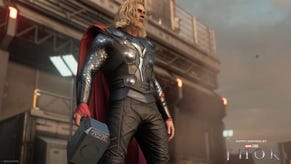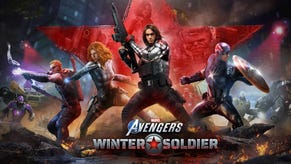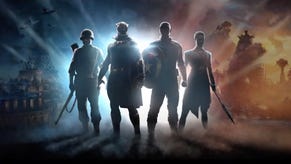Marvel's Avengers: our first look at the upcoming generational divide?
Challenged on base consoles, great on enhanced - but is the next-gen the place to be?
It's been a long time since we've enjoyed a new game from Crystal Dynamics - Rise of the Tomb Raider shipped in 2015 - but the wait is almost over, and for the last couple of weekends we've had the opportunity to enjoy extended play with the studio's latest work: Marvel's Avengers. Take an enhanced version of the Foundation Engine that powered Lara Croft's adventures, add in some of the most iconic characters from comic book history and then combine both single-player campaign with Destiny-style PVE action and you have a hugely ambitious project from Square-Enix - a game that spans the console generations. It runs well on PS4 Pro and Xbox One X, it should scale beautifully to next-gen - but there are clear and obvious challenges for the base PlayStation 4 and Xbox One.
The concept behind Marvel's Avengers is straightforward enough: widely published marketing materials have already set the scene, with the game kicking off with a prologue showing the team at the height of its powers, tackling a terrorist attack on the Golden Gate bridge. Perhaps inevitably, everything goes wrong, the Avengers are 'played', a major disaster takes place and the Avengers disassemble - which is where the game kicks off properly. The beta is frankly huge, with at least a couple of hours' play to see everything there is to see before digging deeper into the multiplayer component.
Throughout, the game technology on display is remarkable. The prologue sees Crystal Dynamics setting out the stall for its revised engine, showcasing a detail-rich, effects-heavy pipeline, able to transition seamlessly from set-piece to cutscene to set-piece. Each of the primary Avengers has a chance to shine and it's here where the stage is set for what I think is probably the best Hulk game I've ever played. The density of the action and the sheer power and glory of the destruction simply doesn't let up. The Avengers' character rendering - from a technical perspective, at least - is second to none, with a remarkable level of attention to detail present across the presentation. This is an expensive game with remarkable production values, and it shows.
It's also a game of two halves - based on the beta, at least. To access the multiplayer component, completion of single-player missions is a must and the ongoing narrative of Kamala Khan and Bruce Banner seeking to rebuild the Avengers takes centre-stage. After the comically named 'war table' is activated by a rebooted JARVIS, it's Destiny time. Here, the action shifts more into selectable mission mode, with a range of levels of various sizes. It's here where Crystal really pushes its new technology to varying degrees of success, based on the console you're playing.
Make no mistake, this is a demanding game and the evidence suggests that it's taxing on both CPU and GPU, meaning that the platform comparison breakdown - based on the beta code, let's not forget - is very interesting. Crystal has built in a great degree of scalability on the graphics side of the equation, and at the core of it all is temporal anti-aliasing/super-sampling paired with dynamic resolution scaling. The vanilla Xbox One and PlayStation 4 both scale between 1080p and 720p according to load, but various effects buffers appear to render at a lower-than-native pixel count, often muddying the image. PlayStation 4 looks a touch blurry and grainy, but the impact to Xbox One is even more profound. The prologue and campaign missions just about hold up, but image quality takes a battering once we move into the multiplayer game.
My take is that Marvel's Avengers is a game built to scale onto future hardware, simply because the experience on the enhanced machines is so much better - meaning that by extension, the foundations are there for a storming PS5 and Series X experience. Both PS4 Pro and Xbox One X target 4K resolution (with PS4 Pro using a reconstruction approach that looks a lot like checkerboarding) again with DRS. These consoles seem to benefit from a wider resolution window in percentage terms compared to the base units, meaning that we're far less likely to get performance drops owing to GPU constraints. Expect both machines to scale between 50 to 60 per cent of 4K all the way up to full resolution, but the greater degree of latitude in resolution scaling combined with vastly improved typical pixel counts produce a night-and-day improvement over the base machines.
The evidence also suggests that Marvel's Avengers is profoundly impactful on CPU resources too - specifically in the multiplayer areas, and especially in the relentless stress test that is the Eastern Seaboard stage. The base machines can hit 20fps or even lower, while the window for the enhanced consoles is typically 25fps to 30fps - though general consistency is much improved. When hell really breaks loose, performance can suffer and it's a perfect storm for the older machines: DRS and lower resolution buffers produce some very poor results (especially on the base Xbox One) and while the PS4 Pro and Xbox One X hold up better, it's clear they're having issues when the action is at its most intense.
Both of the enhanced machines throw up some interesting results on the CPU side owing to the presence of a 1080p performance mode, accessible at any time from the options. The frame-rate is unlocked and - especially on Xbox One X - we get to see how Marvel's Avengers performs when GPU isn't an issue but CPU definitely is. With Microsoft's machine, six teraflops of GPU are oodles of bandwidth are deployed to service a full HD pixel count, which must surely remove graphics as the bottleneck, leaving the AMD Jaguar cores exposed. The end result is that in the Eastern Seaboard stage, the frame-rate can be anything from 25fps to 60fps depending on just how stressed the CPU is. The variability is so jarring that it simply makes much more sense to stay on the default quality mode, where the Pro and X typically hum along nicely enough.
It's a demanding game then, which brings us back to our original point - the idea that Marvel's Avengers is primarily designed to scale into the future, while accommodating (albeit awkwardly at times) the consoles of today. The PlayStation Blog has already detailed exactly how PlayStation 5 will benefit, with improved textures, pushed out LODs, better ambient occlusion and revamped screen-space reflections. The performance mode gets upgraded from 1080p to dynamic 4K - and with the power of the Zen 2 CPU architecture, we would hope to see the bottleneck that hampers the existing consoles' performance modes removed. An Xbox Series X version has also been confirmed and I'd expect to see similar enhancements. How the game will pan out on Google Stadia remains to be seen - but again, the cloud servers do have far superior CPU capabilities to the current-gen machines and Foundation Engine titles on the cloud system have worked out well thus far.
All of which leaves the PC version, which is also included in the current beta and made its debut last weekend. I didn't get to spend too much time with this one as the code seemed much more beta-like than its console siblings. It froze the first time I played and after a restart, it swiftly became clear that anything from high to very high to max settings could not achieve anything like a sustained 4K60 on an RTX 2080 Ti. Meanwhile, the dynamic resolution scaling setting appeared to make performance worse, while AMD contrast adaptive sharpening/upscaling also failed to improve frame-rate. For the time being at least, it's worth giving Square Enix the benefit of the doubt. Game-optimised drivers from AMD and Nvidia only arrived after the beta weekend - and just generally, I hope to see a good PC port, especially as one of gaming's unsung heroes - developer Nixxes - is involved. We'll be returning to the PC beta next weekend for a closer focus as it does appear to feature the PS5 next-gen features.
Meanwhile, regardless of what games machine you have, I do recommend giving Marvel's Avengers a go as the game moves into its final beta weekend in a few days' time. You'll be surprised at just how much of the game Square-Enix allows you to sample - and you'll have no doubt by the end of the experience whether this is a game for you. Personally, I've found myself enjoying Marvel's Avengers more having put two weekends' worth of play into it. On the one hand, Hulk aside, it's difficult to overcome the challenging character designs and sub-par voice acting. It's as if Crystal is caught between delivering unique takes on the heroes while attempting to mimic the MCU icons, and it jars. But on the other, the more I play, the more I enjoy the game mechanics - the fighting system seems to have a lot of depth and when everything comes together, there's a profound enjoyment in watching the carnage unfold. The beta also provides enough of the single-player experience to make me want to play more of it, so I'll be looking forward to the release of final code on September 4th.



















